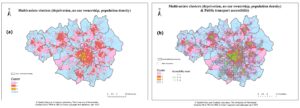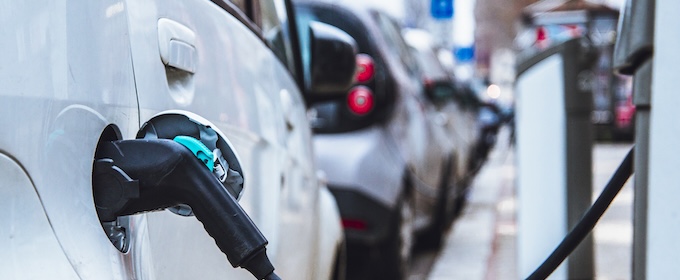While electric vehicle (EV) sales continue to rise, EV ownership remains inaccessible to large portions of the population. Research by Helen Zheng and Arijit De addresses this by using geospatial analysis and agent-based simulations (ABSs) to identify priority areas for EV infrastructure in Greater Manchester (GM). In this article, they discuss how these steps will help the UK reduce its domestic transport emissions to net zero, while preventing low-income and socially disadvantaged communities from being left behind.
- Domestic transport is the UK’s largest source of emissions, accounting for 28% of the total, with 89% of this coming from road vehicles.
- There are two main groups at risk of being left behind in the transition to EVs: those with low incomes living in transport poverty, and those without off-street parking.
- To support these groups in the journey to net zero, local and national government should implement more shared mobility services (for example e-car sharing clubs), alongside improvements to public transport.
The UK is legally required to reduce its greenhouse gas (GHG) emissions to net zero by 2050. Since 2014, domestic transport has been the largest source of GHG emissions, accounting for 28% of the UK’s total in 2022, of which 89% came from road vehicles. While EVs are central to decarbonising transport, for many households, especially those without off-street parking or living in deprived areas, EV ownership remains unfeasible. The government committed in December 2024 to making Britain a clean energy superpower, including ensuring that “the public enjoy the full benefits of home-grown clean power”. To achieve its climate targets, the UK must continue to support the transition to EVs, and our research aims to explore how this transition needs to be aligned with efforts to improve opportunities for those on low incomes.
Communities at risk of being left behind
To support a fair and effective rollout of EV infrastructure, we conducted spatial analysis to identify priority areas across GM where investment could have the greatest social impact. Using these innovative analytical and modelling techniques we pinpointed the neighbourhoods most in need of alternative mobility solutions. In collaboration with Transport for Greater Manchester, we identified two main types of priority areas:
- Households in transport poverty, characterised by limited public transport access, high social deprivation and no car ownership.
- Households with one or more petrol/diesel cars, but no off-street parking or home charging access, and limited public transport access.
Cluster 2 (red) in Figure 1(a) highlights areas with high levels of deprivation and population density. While some of these areas have a degree of public transport connectivity, the overlay with accessibility data (Figure 1b) shows that several of these areas fall within the lowest accessibility bands (levels 1–4). These areas are identified as priority 1 areas. This indicates that public transport does not sufficiently meet residents’ mobility needs. These areas should be the highest priority for improved public transport provision, as they represent communities experiencing severe transport poverty, and are generally unable to afford to own an EV.

The areas classified as Cluster 4 (red) in Figure 2a are characterised by moderate to high population density, high levels of terraced housing, and moderate levels of car ownership. These areas suggest households that have the potential to shift to EVs but cannot due to affordability and infrastructure barriers. The overlay with public transport accessibility (Figure 2b) further reveals that some of these locations also experience poor public transport access, with residents being reliant on private vehicles, unable to afford EVs and lacking home charging options. This group highlights the risk of widening inequality in the EV transition if investment overlooks those facing structural barriers to EV adoption.

Using agent-based simulations
To solve these problems, we used an agent-based simulation (ABS). ABSs model the actions of individuals, drivers, and users in an environment that mimics real world spatial and social conditions. Unlike traditional models, ABSs allows us to capture dynamic and adaptive nature of transport behaviours, especially in response to new interventions. Our simulations reveal that targeted deployment of e-car clubs in priority 1 areas and priority 2 areas, supported by tailored pricing models and local infrastructure, could lower the economic and behavioural barriers to EV adoption.
By modelling agents with varying socioeconomic profiles, mobility patterns, vehicle ownership status, and access to infrastructure, we evaluated how different communities are likely to use e-mobility options under different conditions. This approach is particularly powerful for identifying where car clubs might effectively reduce transport poverty and for testing the impact of different policy scenarios before implementation.
Recommendations
To ensure the transition to EVs does not unfairly impact those from socioeconomically disadvantaged groups, investment should prioritise areas where residents face high deprivation, lack of off-street parking, and unaffordable vehicle costs. Our spatial mapping and clustering approach provides an evidence-based tool to identify these areas.
While expanding charging infrastructure is a necessary step, it is not sufficient. Local authorities, metro-mayors, the Department for Transport (DfT), the Ministry Housing, Communities, and Local Government (MHCLG), and the Department for Energy Security and Net Zero (DESNZ) should prioritise investment in e-car clubs and pay-as-you-go EV schemes. Austria has already successfully piloted e-car sharing programmes in both urban and rural areas, increasing access for lower-income users and improving adoption rates.
Areas with high deprivation, high population density and no access to private vehicles often rely on public transport, which in some areas is insufficient. Enhancing public transport options in these areas is critical for social inclusion in transport decarbonisation process, especially in areas where EV ownership may never be feasible for a large share of the population. ABSs show that in transport-poverty hotspots shared EVs alone are not sufficient. Public transport remains essential for inclusivity, particularly where households cannot afford or access any form of personal vehicle. Enhancing coverage and frequency in these zones should be a parallel strategy.
For priority 1 and priority 2 areas, metro-mayors are well placed to promote shared mobility schemes, such as EV car clubs. For instance, GM’s devolution deal gives significant powers over transport planning, housing, and spatial development. Embedding shared mobility, alongside its existing sustainable transport initiatives, into the city-region’s transport strategy could accelerate the transport decarbonisation while supporting inclusive economic growth. DfT, MHCLG, and DESNZ should support local authorities to implement shared mobility options (including EV car clubs) while improving public transport to tackle transport poverty.
Transport decarbonisation should not be addressed in isolation. Coordinated, cross-sectoral governance helps align infrastructure investment with behavioural change and broader sustainability objectives. For example, planning EV charging infrastructure requires collaboration with energy providers to manage grid impacts. ABSs can be a powerful evaluation tool within integrated planning efforts and help forecast grid demand from EV infrastructure, simulate uptake under different incentive schemes, or identify synergies between housing retrofits and EV access. Local authorities should be supported to adopt ABSs, and national government could consider integrating ABS capabilities into central infrastructure appraisal guidance.
